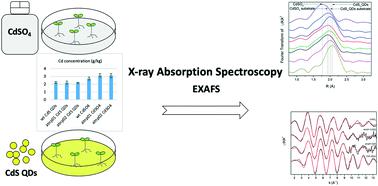当前位置:
X-MOL 学术
›
Environ. Sci.: Nano
›
论文详情
Our official English website, www.x-mol.net, welcomes your
feedback! (Note: you will need to create a separate account there.)
The fate of CdS quantum dots in plants as revealed by extended X-ray absorption fine structure (EXAFS) analysis
Environmental Science: Nano ( IF 5.8 ) Pub Date : 2020-02-25 , DOI: 10.1039/c9en01433k Marta Marmiroli 1, 2, 3, 4, 5 , Giovanni Orazio Lepore 6, 7, 8 , Luca Pagano 1, 2, 3, 4, 5 , Francesco d'Acapito 6, 7, 8 , Alessandra Gianoncelli 5, 9, 10 , Marco Villani 4, 5, 11, 12 , Laura Lazzarini 4, 5, 11, 12 , Jason C. White 13, 14, 15 , Nelson Marmiroli 1, 2, 3, 4, 5
Environmental Science: Nano ( IF 5.8 ) Pub Date : 2020-02-25 , DOI: 10.1039/c9en01433k Marta Marmiroli 1, 2, 3, 4, 5 , Giovanni Orazio Lepore 6, 7, 8 , Luca Pagano 1, 2, 3, 4, 5 , Francesco d'Acapito 6, 7, 8 , Alessandra Gianoncelli 5, 9, 10 , Marco Villani 4, 5, 11, 12 , Laura Lazzarini 4, 5, 11, 12 , Jason C. White 13, 14, 15 , Nelson Marmiroli 1, 2, 3, 4, 5
Affiliation

|
The use of quantum dots (QDs) is widespread and as such, the potential risk associated with their dispersion in the environment has stimulated research on their interaction with potential sensitive receptors. To this end, the model plant Arabidopsis thaliana wild type (wt) and two mutant lines known to be tolerant to cadmium-based CdS QDs but not to CdSO4 were exposed to CdS QDs or CdSO4 at sub-inhibitory concentrations for 20 days. X-ray absorption spectroscopy (XAS) was employed to investigate cadmium speciation in the cellular environment of the plants after treatment. After exposure to CdS QDs and CdSO4, differences in biomass were observed between the wt and mutants, but the form of Cd in the treatment had a marked influence on the cadmium atomic environment. The spectra of whole plant samples were found to be compatible with a mixed O/S coordination; while Cd–S distances did not show much variation, Cd–O distances varied from ≈2.16 Å in samples grown with QDs to ≈2.22 Å in those grown with CdSO4. In addition, the number of Cd–S bonds in plants grown with QDs was higher than Cd–O bonds. XAS data showed that CdS QDs were bio-transformed after their uptake; the particle original structure was modified but not totally eliminated, and Cd atoms were not released as Cd(II) ions. These findings show the nanoscale specific response of plants to QDs, provide important insight into understanding the nanoparticle fate in plants and in the environment, and have implications for both risk assessment and design of appropriate remediation strategies.
中文翻译:

扩展X射线吸收精细结构(EXAFS)分析揭示了CdS量子点在植物中的命运
量子点(QD)的使用十分广泛,因此,与其在环境中分散相关的潜在风险刺激了人们对其与潜在敏感受体相互作用的研究。为此,将模型植物拟南芥野生型(wt)和两个已知可耐受基于镉的CdS QD但不耐受CdSO 4的突变株以亚抑制浓度暴露于CdS QDs或CdSO 4达20天。X射线吸收光谱法(XAS)用于研究处理后植物细胞环境中的镉形态。暴露于CdS QD和CdSO 4之后,wt和突变体之间观察到生物量的差异,但处理中Cd的形式对镉原子环境有显着影响。发现整个植物样品的光谱与混合的O / S配伍兼容。尽管Cd–S的距离变化不大,但Cd–O的距离从QDs生长的样品中的〜2.16Å到CdSO 4生长的样品中的〜2.22Å不等。此外,在QDs下生长的植物中Cd–S键的数量高于Cd–O键。XAS数据表明,CdS量子点被吸收后会发生生物转化。粒子的原始结构被修饰但未被完全消除,并且Cd原子没有以Cd(II)离子。这些发现表明,植物对QD的纳米级特异性反应,为了解植物和环境中的纳米粒子命运提供了重要见识,并且对风险评估和适当补救策略的设计都具有影响。
更新日期:2020-02-25
中文翻译:

扩展X射线吸收精细结构(EXAFS)分析揭示了CdS量子点在植物中的命运
量子点(QD)的使用十分广泛,因此,与其在环境中分散相关的潜在风险刺激了人们对其与潜在敏感受体相互作用的研究。为此,将模型植物拟南芥野生型(wt)和两个已知可耐受基于镉的CdS QD但不耐受CdSO 4的突变株以亚抑制浓度暴露于CdS QDs或CdSO 4达20天。X射线吸收光谱法(XAS)用于研究处理后植物细胞环境中的镉形态。暴露于CdS QD和CdSO 4之后,wt和突变体之间观察到生物量的差异,但处理中Cd的形式对镉原子环境有显着影响。发现整个植物样品的光谱与混合的O / S配伍兼容。尽管Cd–S的距离变化不大,但Cd–O的距离从QDs生长的样品中的〜2.16Å到CdSO 4生长的样品中的〜2.22Å不等。此外,在QDs下生长的植物中Cd–S键的数量高于Cd–O键。XAS数据表明,CdS量子点被吸收后会发生生物转化。粒子的原始结构被修饰但未被完全消除,并且Cd原子没有以Cd(II)离子。这些发现表明,植物对QD的纳米级特异性反应,为了解植物和环境中的纳米粒子命运提供了重要见识,并且对风险评估和适当补救策略的设计都具有影响。











































 京公网安备 11010802027423号
京公网安备 11010802027423号